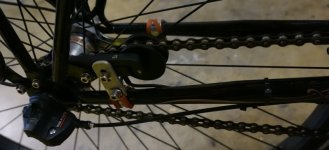Alex W said:
In torque sensing mode the bottom bracket is sampling over a full revolution of the cranks, I don't think it cares about the wheel. It would be great to get some confirmation though, if it does care about the wheel rpm then I'll find some more magnets and try it out with 4.
Hey Alex, the wheel diameter has nothing to do with it. You do need to make sure that the # Pas Poles is set to 8, and that the Trq Averaging is also set to 8 (or 16 or 24, but those changes would make it less rather than more responsive by averaging over multiple pedal rotations).
What firmware version are you running right now? At some point the starting behavior was updated so if you just start to apply torque on the crank after you haven't been pedaling, then it only does an immediate averaging of that force up to the point where you have the full revolution in place, so it's acting to a pretty immediate signal and not waiting for you to do a full pedal turn.
If there seems to be a lag at startup, then the usual culprits would be either your Start RPM threshold being too high (set it to a low value like 8-10rpm), your WGain setting being too low (the CA is operating in a power limited feedback mode, so a tightly tuned watts feedback gain is important), and/or your throttle ramp rates being too slow. It's really useful to look at both the 3rd screen (showing human watts/rpm and output motor watts) as well as the diagnostics screen (Showing output throttle voltage level) when you are trying to understand what's happening to dial in the behavior.
I think that there is also a bug where a low aux-level seems to also cause more lag. I sometimes have to "trick" the motor into turning on by setting my assist level to 1, get the motor going, then drop it to 0.5. I've ridden blocks without any aux power at 0.5.
There isn't any bug observed here but it's also possible that the torque sensor's zero torque offset has drifted, or that your Assist Start is a bit high, 20-30 watts is usually sufficient for that.
It would be great if someone with the source code to the CAv3 would ride their primary bike without a throttle for a month. The system is a lot less responsive than some other torque-only bikes that I've ridden. A friend gave up and installed a throttle on his torque assist bike. I don't want to do that, but do want less lag.
The THUN sensor will always have the limitation that an application of torque on the left crank will never be noted, but with sensors like the TDCM units that respond to left and right pedal forces and which also have a higher PAS pole count the behavior can be made quite instant.
I'm also surprised that the bike doesn't cut power to the motor as soon as it sees that my pedal RPMs have stopped. That is easy to measure and the Thun BB has 8 PAS poles. So if I'm pedaling at 90rpm (my normal) there are 12 pole pulses per second. Every time a pole signal happens a timer should start that is approximately 2 times longer than the recent time decayed pole period. So that would kill the motor in one sixth of a second. Today it seems to wait for what would have been one pedal revolution, which is 2/3rds of a second at 90rpm.
First, if you haven't yet be sure to install the latest P10 or P11 firmware and make sure that the quadrature mode is set to "2-wire", since this will help in the cutoff time and will also make it absolutely instant with the slightest back pedal. Secondly, you have full control over the cutoff lag time in the PAS setup menu via the Stop Thrsh RPM parameter. Say you set it to 20 rpm = 3 seconds/rev. With the 8 poles of a THUN sensor, then that means if the CA doesn't see a pulse in 3sec/8 = 0.375 seconds, it will shut off. If you'd like it to cut out in 1/6th of a second, then you'd set the Stop Thrsh to 45 rpm, but of course then whenever your pedal cadence falls below 45rpm the CA will keep thinking that you've stopped pedaling. Personally I wouldn't go much above 20-25 rpm for this.
Let me know if any of those things help in getting the behavior response you are after.
This is all a bit off topic form the original post, but I have some stuff to add to that as well too. First, we've been getting some samples of the BeamTS device without any of the internal throttle circuitry so that it's less expensive and easier to hook up to a CA3 for those interested in a lower cost pedal force that doesn't require a BB replacement, with the limitation that the calibration goes out of wack if you have derailleur gears. The raw signal goes form about 3.3V to 3.8V, so not as much of a range than we are used to seeing for best resolution but it still works great and Robbie has it installed on the rear of an IGH bike to good effect.

And secondly, there are many many (at least a dozen I'd say) companies advertizing torque sensing bottom brackets now, like Dapu:
http://www.dapumotors.com/torque-sensors/
Sempu
http://sempumotor.en.alibaba.com/productgrouplist-219984346/Dual_Side_Torque_Sensor.html
and countless others, so hopefully with more options on the market the prices will come down. Do keep in mind though that these are all WAY cheaper than a commercial/industrial torque sensor with similar specs.
-Justin


